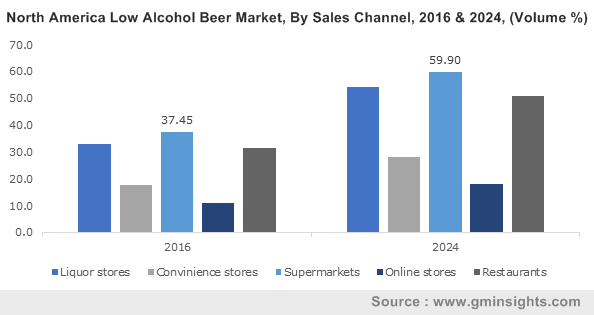Non-alcoholic beer market to accrue remarkable proceeds via an enthusiastic product landscape, global industry share to exceed 25-billion-dollar frontier by 2024
Publisher : Fractovia | Published Date : 2018-04-05Request Sample
Owing to a worldwide escalation in the preference for low liquor content beverages, the non-alcoholic beer market size has proliferated at an outstanding pace over the past decade. This has been complemented with the fact that the disposable incomes among the global middle-class population have shot up which has further provided a commendable boost to the overall non-alcoholic beer industry. The rising consolidation and maturation of this business space can be deciphered from the fact that the global non-alcoholic beer industry garnered revenue in excess of USD 13 billion in the year 2016, according to a study undertaken by Global Market Insights, Inc
Middle East & Africa Alcohol Free Beer Market, By Material, 2016 & 2024 (USD Million)

Elaborating further, one of the pivotal factors to have encouraged leading non-alcoholic beer industry participants to unveil refined products is that the overall alcohol consumption world over has witnessed a drastic reduction in the recent years. Citing an instance to affirm this, the Dublin headquartered Guinness Brewery has recently launched a full-flavored non-alcoholic lager, Open Gate Pure Brew. Reportedly, the latest launch goes on to demonstrate the firm’s renewed interest in zero-alcohol and low ABV beverages which have been the most lucrative products for the overall non-alcoholic beer market players in the recent times.
Launch of fresh products to serve health-conscious costumers: Reshaping the non-alcoholic beer market
Over the past few years, the eminent non-alcoholic beer industry players have focused on launching new alcohol-free drinks, given that the number of health-conscious costumers is on the rise. Enumerated below are a few instances of product revelations that have are being termed as rather pathbreaking by the market analysts:
- With the major objective of offering right taste of alcohol-free beer to its European consumers, the principal non-alcoholic beer industry stakeholder Heineken has apparently unveiled an upgraded edition of its flagship drink, Heineken 0.0. Apparently, the firm’s Master Brewers produced the new zero-alcohol beer using only natural ingredients and a unique recipe for a distinct balanced taste. Reportedly, the latest beer, which has only 69 calories per 33cl bottle, has proved to be quite popular across Netherlands, Spain, Austria, and Poland.
- Brewed in a similar way as a normal beer, the ‘Without’ range of England based St Peter’s is the third range of zero-alcohol drinks launched by the upcoming non-alcoholic beer market player. Predominantly targeted toward lager and ale drinkers, the company now aims to serve organic and vegan beers to its health-conscious consumers. Following the success of its first two zero-alcohol drinks, the latest offering intends to offer rich alternatives over the alcoholic beers.
Coupled with the aforementioned instances, it is quite imperative to state that the consumer appetite for quality and more choices in the alcohol-free category of drinks would certainly propel the non-alcoholic beer market share expansion in the immediate future.
Meanwhile, it has to be noted that among the chief obstacles to have mired the product penetration is the uneasiness among consumers regarding the taste of non-alcoholic beers. Apparently, scientists around the globe, of late, have been researching persistently to develop novel brewing procedures in order to improve the taste of alcohol-free beer. Researchers at the Valladolid University in Spain have reportedly devised a unique method to enhance the conventional taste of non-alcoholic beer.
Apparently, the new technique deploys a semipermeable membrane which separates the liquid and gaseous phases of alcohol from the alcoholic beer. With this process the aromatic compounds can be recovered and the gaseous phase can then be extracted and added to zero-alcohol beer. This new method would invariably aid the leading non-alcoholic beer market players to manufacture more palatable ‘alcohol-free’ varieties of beer in the forthcoming years, cite industry analysts.
Along with the rapidly changing consumption patterns and an exponential rise in health awareness, the global non-alcoholic beer industry is bound to witness a commendable progression over the forecast time frame. According to reliable estimates, the overall non-alcoholic beer market share is anticipated to exceed USD 25 billion by 2024.